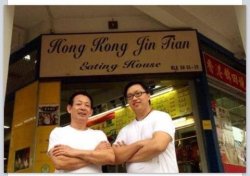 Another massive rent-hike and another cheap local eatery out of business. The government has made a point of telling us that while cost of living may be expensive for expatriates, things are still very affordable for the so-called “average local” – but this logic is problematic. Firstly because it is the cheap local eateries that cannot afford to carry on in high-cost Singapore, but also because the distinction between expat and local cost of living depends on a very narrow world view. With an eye on income inequality more generally, it seems clear that businesses catering to the lower cost “average local” market are the ones being squeezed out, and the less well off are the ones suffering.
Another massive rent-hike and another cheap local eatery out of business. The government has made a point of telling us that while cost of living may be expensive for expatriates, things are still very affordable for the so-called “average local” – but this logic is problematic. Firstly because it is the cheap local eateries that cannot afford to carry on in high-cost Singapore, but also because the distinction between expat and local cost of living depends on a very narrow world view. With an eye on income inequality more generally, it seems clear that businesses catering to the lower cost “average local” market are the ones being squeezed out, and the less well off are the ones suffering.
The two faces of Singapore
One face of Singapore is represented by a simple plate of roast duck with rice costing a few dollars. The other face is a gourmet thin crust pizza costing sixteen dollars. On Tiong Bahru’s Eng Hoon Street, both exist side by side, separated by just a few hundred metres – the former being the soon to close Jin Tian Eating House, the latter is the aptly named Two Face Pizza and Tap Room. The price disparity between the two establishments is significant – two face is over five times more expensive for dinner – but this doesn’t seem to hurt business, walk past any evening and the place is likely to be packed out – mostly with Singaporeans.
There is a simple economic lesson behind the fact that a sixteen dollar pizza sells well in Tiong Bahru. To be blunt, selling a three dollar roast duck rice on the same street is an inefficient way to make money by comparison. Putting aside any personal preference for roast duck, a landlord who wants to maximise his return on investment is likely to realise that greater revenues and higher rents are available to other businesses that can deliver the premium-price experience. And this seems to be a lesson that has been learned on Eng Hoon Street. Jin Tian Eating House is closing down because the landlord increased their rent by a whopping 50% to $12,000, after seeing another coffee shop over the road rent out its stalls for $20,000 per month.
Expats, locals, rich and poor
The government has gone to some lengths to convince that cost of living remains very affordable for what they term the average local. But with cheap local eateries dropping like flies (one, two) in the face of rent hikes, for how long will that remain true – if it ever was? And despite Tiong Bahru being popular with expats, the dinner crowd at Two Face is predominantly Singaporean, betraying the false dichotomy that runs through government thinking on cost of living – that expats pay high prices, but locals do not. In land-scarce Singapore the richer and the poorer are competing for limited resources, and as soon as there are enough residents with enough disposable income to pay for the more expensive eating options, cheaper alternatives are likely to be squeezed out of the market. This is the root cause of Jin Tian Eating House’s demise, and it is the average local who loses an affordable dinner option as a result.
It has been reported many times that income inequality is particularly high in Singapore, a fact that exacerbates the cost of living issue. In a world of total equality, there would be no rich and poor, and the spending power of the rich would therefore not exist to push up the value of limited resources such as land and rentals. Conversely, greater inequality like we do see in Singapore leads to a larger market for more expensive goods, and increases the chances that cheaper alternative businesses will not be able to compete. Obviously it is not just in the market for hawker stall rentals that we see this story played out. From private property to certificates of entitlement and many other goods, prices for scarce resources have increased dramatically in recent years, pushed up further by the sort of millionaire and billionaire immigrants that PM Lee is apparently so keen to attract to Singapore.
To me this endless courting of the rich does not seem sustainable. We know Singapore is already very rich on paper, but the wealth is spread very unevenly. The challenge now should not be to keep making the pie bigger, but to share it out more fairly. Reducing income inequality would increase the relative spending power of the average local, making businesses such as Jin Tian Eating House more sustainable. Conversely it may reduce slightly the market for gourmet pizzas but probably not very much. The real impact should be aimed at the very high-end, making private property and COEs more affordable to aspirational middle-income families – ones whose dreams of achieving the 5 Cs have become increasingly unattainable in recent years.
Surely a vision for Singapore where wealth is shared more equally and where the average local has greater spending power is preferable to the current reality of extreme inequality.
Pingback: What will the average local eat tomorrow? | Weekender Singapore